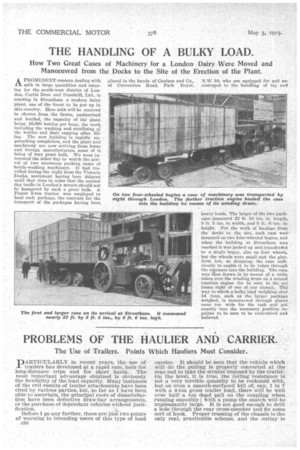PROBLEMS OF THE HAULIER AND CARRIER.
Page 22

Page 23

If you've noticed an error in this article please click here to report it so we can fix it.
The Use of Trailers. Points Which Hauliers Must Consider.
DARTICULARLY in recent years, the use of trailers has developed at a rapid rate, both for long-distance trips and for short hauls. The most important advantage obtained is obviously the flexibility of the load capacity. Many instances of the evil results of trailer attachments have been cited by various parties, but, so far as I have been able to ascertain, the principal roots of dissatisfaction have been defective draw-bar arrangements, or the purchase of dependant vehicles without justi fication. • • Before I go any farther, there are just two points of warning to intending users of this type of load c38 carrier. It should be seen that the vehicle which will do the pulling is properly converted at the rear, end to take the strains imposed by the trailer. On the level, it is true, the rolling resistance is not a very terrible quantity to be reckoned with, but on even a smooth-surfaced hill of, say, 1 in 7 with a 4-ton gross trailer load, there will be well over half a ton de,ad pull on the coupling when running smoothly; tvith a pump the snatch will be unpleasantly large. It is not good enough to drill a hole through the rear cross-member and fix some sort of hook. Proper trussing of the chassis is the only real, practicable scheme, and the outlay is well repaid by the subsequent good effect, on maintenance costs.
Some form of spring coupling is advisable to minimize the effects of shocks, and a safety device to prevent the draw-bar jolting out of engagement is much to be recommended.
The second point concerns insurance. Most policies on existing vehicles, when no trailer is specified in the document, will be inoperative if a trailer be attached unless the company is notified and a premium adjustment made.
Roughly speaking, there are two phases of use. for trailers either as a temporary or a .permanent means of increasing the load capacity. In the first instance it may be useful to be able to take on a special job, the nature and bulk of which demand more space than is provided on the normal vehicle alone. Loading' and unloading delays may be reduced, particularly if two trailers. be used, one being in action and the other at a terminal point, or the handling of loads which have different destinations may be facilitated.
The use of a trailer as a permanent portion of a travelling unit is preferred in many cases to the employment of one vehicle of a large type, but careful consideration must be 'given to the matter. The lower legal speed limit has to be contended with, however, if peaceful police districts are to be traversed, there may not be much weight attached to this disadvantage. For special work, such as brick transport, with long .periods of terminal delays (unless hoppers are used), the economy of operation may be marked. Tipping trailers for ballast or similar loads may obviate the necessity for keeping spare trailers in operation for ease of unloading.
After all, it boils down to, the old question of finance ; therefore, a few figures must be brought in to help in coming to a decision. Consideration must be given to the question of the frequency of use of .a trailer. Roughly, there will be about 6s, 7d. Der week or £13 10s. 4d. per annum for standing charges. It will be seen that, apart from running costs, this sum must be spread over the charges for the various jobs concerned. If the trailer is only going out at rare intervals, the burden of standing charges and depreciation will be somewhat serious, and the consequent bills to customers will be on the high side, in order to cover the outlay. In such circumstances, the hire of a trailer at s..,omewhere about 10s. a day may be a More economical procedure.
Running costs will be approximately 2,12d. per mile, which, of course, is easier to reckon with, as it is a figure proportionate to use.
An inquirer is concerned with the charges• he should make for the use of a 4-ton lorry with a trailer ; the latter ye-hi-etc he hires for occasional jobs. He states that his weekly mileage is about 200. The lorry alone should bring in _about is. Sid. per mile, in order to show a profit of £4 10s, per week. An extra 4d. per mile should be added for the use of the trailer, totalling 2s. Did., to yield a further profit of about £1 a week. When the trailer is hired, at least 30 miles must be done in the day and charged for, to cover the bare hire cost of 10s.
The correspondent states that he has ,to quote his hire charges irrespective of the weekly mileage, in order to get business at all. I would advise him to study the operating costs tables published in our issue of February 17th and compare the differences revealed by the, various figures for respective mileages. If he cannot get a fair price for •a job, it may be strongly advisable to look elsewhere for loads that 00 pay. S.T.R.
































